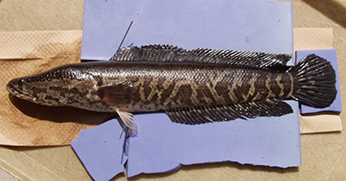(Family Channidae)
General Description
 Northern snakehead (Channa argus). Photo by Buck Albert, US Geological Survey.
Northern snakehead (Channa argus). Photo by Buck Albert, US Geological Survey.
Snakeheads are freshwater fishes belonging to the Channidae family. Of the 38 different species belonging to the Channidae family, only around 12 of them are considered invasive or potentially harmful. Snakeheads have a long, torpedo-shaped body with long, continuous dorsal and anal fins that run
along the top and bottom of their body nearly reaching their tail fin. They get their name from their body shape, as well as the presence of large scales (on some species) and location of their eyes on top of their heads. Snakeheads have small heads with large, wide mouths and sharp teeth. They have a suprabranchial organ, or primitive lung for respiration, which allows them to breathe air and survive out of water for up to 4 days, if they stay moist. Snakeheads are generally tan to black in color and patterned with contrasting spots or blotches. Some species of snakehead can grow to over 4 feet long and weigh more than 40 pounds. Snakeheads are sometimes confused with bowfin (
Amia calva), a native of the eastern U.S. that is also restricted in California. However, snakehead pelvic fins are located directly behind their pectoral fins, unlike the bowfin, whose pelvic fins are found in the belly region, nearer their short anal fin.
Current Distribution
Currently, snakeheads are not established in California. The only confirmed report of snakehead in California was a single northern snakehead (Channa argus) collected from Silverwood Lake in San Bernardino County in 1997. In the United States, snakeheads have been introduced into several eastern states; northern snakeheads have established populations in the Potomac River in Maryland, Virginia, and Washington D.C. In addition, the blotched snakehead (Channa maculata) has been established in Oahu, Hawaii since the late 1800s.
Habitat Preference
Snakeheads are native to tropical Africa and Asia, and though habitat preference varies by species, most occupy streams and rivers. Snakeheads can also be found in swamps, rice paddies, ponds, reservoirs, ditches, and canals. Northern snakeheads prefer shallow, stagnant ponds or swamps with mud substrate and vegetation. All species of snakehead can tolerate low oxygen conditions. Some species can tolerate a wide range of temperatures, including freezing conditions; however some require warmer, tropical temperatures. All species of snakehead have little to no tolerance for saltwater.
Pathways
Snakeheads are most commonly introduced to new areas as a food resource. Other means or purposes of introduction include accidental release during stocking of other fish species, release by aquarium owners, intentional stocking for sport fishing, culture-based medicinal and pharmaceutical uses, and release during cultural or religious ceremonies. In addition, with their ability to breathe air, some species of snakehead are capable of moving (wriggling and flopping) across land and dispersing to uninfested waters. All species of snakehead (family Channidae) are on California’s list of restricted animals and cannot be imported, transported, or possessed without a permit.
Impacts
Snakeheads are voracious and aggressive predators that eat a variety of animals, including fish of all sizes, frogs, small reptiles, crustaceans, insects, sometimes young birds and mammals, and their own young if other food sources are limited. With no known predators, snakeheads dominate the food web and not only prey on native species, but compete with them for food and habitat. Snakeheads could have an impact on local economies if they were to out-compete commercially important sportfish species. In addition, snakeheads also carry many parasites, which they could potentially introduce to native species in the waterbodies they invade.
Actions Taken if Found
If this species is found in California, do not release it. Preserve (freeze) the specimen and immediately contact the CDFW Invasive Species Program, or email us at Invasives@wildlife.ca.gov, or (866) 440-9530.